Millions of small businesses use the Facebook platform as a marketing tool because it can be a lucrative sales channel. A few hours per week invested in social media management can pay dividends in the long run.
Many of Facebook’s three billion monthly users use the social media platform to engage with brands and discover new products. Statista also notes that 69 million global social media shoppers will make purchases on Facebook by 2025.
It’s crucial for you to develop a Facebook presence that encourages visitors, both new and repeat, to convert. In this guide, learn how to use Facebook to build brand awareness, drive traffic to your website, and generate sales.
What is Facebook marketing?
Facebook marketing is the process of using Facebook’s social media platform to reach your target audience. Once you’ve reached them, the goal might be to get them to like your ecommerce business’s page, subscribe to your email list, visit your website, or buy something from your online store.
Benefits of Facebook marketing
Facebook is the most popular social media platform that businesses use for marketing. Studies show that 89% of marketers actively use Facebook to promote a business. Here’s why:
- It’s free. Anyone can market their business on Facebook. The platform has a bunch of features that allow you to connect with potential customers, including business Pages, Groups, Marketplace, and Facebook Shops.
- Reach older demographics. Social media platforms like Snapchat and TikTok are typically used by younger audiences. If you’re targeting older demographics, Facebook is a great channel to use. Almost 44% of its user base are aged 35 years or older.
- Retarget website visitors. You’ve already done the hard work of driving someone to your website. Facebook’s retargeting features stop you from falling at the last hurdle. Reach people who’ve already visited your website without making a purchase—even showing the same products they had in the shopping cart they abandoned.

How to set up Facebook for business
Facebook offers a suite of features to help small businesses build their online presence. Before we get into specific Facebook marketing tactics, set your strategy up for success with this starter checklist.
1. Create a Facebook business page
A Facebook business page is the business equivalent of a personal Facebook profile. Add your brand name, upload a profile and a cover photo, and optimize your bio before you work on building an audience, whether you have just one or multiple Facebook pages.
2. Open a Facebook shop
Selling products online? Sync inventory from your ecommerce website with a Facebook shop. It’ll give future followers the ability to purchase products without leaving the Facebook app.
3. Create a new ad account
Even if you don’t plan on advertising just yet, a Facebook Ads Manager account—which comes as part of the Meta Business Suite—grants access to bonus features for marketing your business, including the ability to boost well-performing posts.
4. Install the Meta pixel
The Meta pixel, formerly known as the Facebook pixel, is a piece of code that tracks website activity and pairs it with Facebook users. You can use it to track Facebook events like website purchases, pageviews, and add to carts.
Learn more about how to install the Meta pixel on Shopify.
5. Verify your Facebook page
Facebook has its own verification badge that signals to users that your brand is credible and owns the page. You can apply for this badge if your business is considered an “authentic presence,” or subscribe to Meta Verified. You must meet the requirements in order to be approved.
Types of Facebook posts
Photo and video posts
Static images stand out in a text-heavy user’s news feed. Share behind-the-scenes photos, how customers are using your products, or product photography, like this example from Flourist.
You can also post videos directly to your Facebook news feed, through a livestream, or as a Facebook Story. High-quality organic video content is favored by the Facebook algorithm because it increases the time people spend using the app.
Text statuses
Some brands see success from posting long-form content to Facebook, though your success with text-only posts depends on your audience. The format works particularly well when storytelling.
Facebook Reels
Facebook Reels work similar to TikTok and Instagram videos (which share the same name). They’re limited to 90 seconds in length and are great content formats to engage the two billion people who watch videos on Facebook every day. Here’s a great example from Kirrin Finch.
Facebook Stories
Facebook Stories, similar to Instagram Stories, are short-lived pieces of content that expire after 24 hours. Users enjoy interacting with this content format because it feels more personal than other organic posts. You can use them to share behind-the-scenes content, create countdowns, and post stickers or GIFs.
11 Facebook marketing tips and strategies
- Understand your target audience
- Customize your Facebook page
- Diversify your content formats
- Post when your audience is active
- Share influencer, user, or collaborative content
- Encourage people to leave Facebook reviews
- Get involved with Facebook groups
- Retarget website visitors
- Run ads with influencer endorsements
- Run A/B tests
- Turn Facebook audiences into email subscribers
1. Understand your target audience
Social media followers are people who’ve opted in to see your content in their news feed. By building your audience, you’ll have a group of people ready to engage with future content.
Be wary of who you attract. While a Facebook following of 10,000 people might seem like an achievement, it isn’t so great if the people following your page have no interest in the products you sell. This is one culprit behind a poor social media conversion rate.
Before running with a new Facebook marketing strategy, you should have a solid understanding of your target market—the people most likely to purchase your products. List traits they have in common and use them as the foundation for the content you share through the platform.
Use a combination of customer feedback surveys, Google Analytics, and competitor analysis to find your target audience’s:
- Demographic data (age, gender, location)
- Interests
- Purchase intent
- Pain points or challenges
- Goals and motivations
2. Customize your Facebook page
Think of your Facebook business page as an extension of your brand. People should get the same feeling when they visit either platform—from the fonts used in your banner to the logo you’re using as your profile photo. This contributes to brand consistency, which has been shown to increase sales by as much as 20%.
When customizing your business’s Facebook page, pay close attention to:
- Your banner
- Your page description (usually your slogan or tagline)
- Your profile photo (which is typically your logo)
The Outrage, for example, uses the same brand identity across both its ecommerce store and Facebook page. Anyone visiting the page can see the brand’s values in its Facebook page description, the tagline in its banner, and the logo as the page’s profile photo.
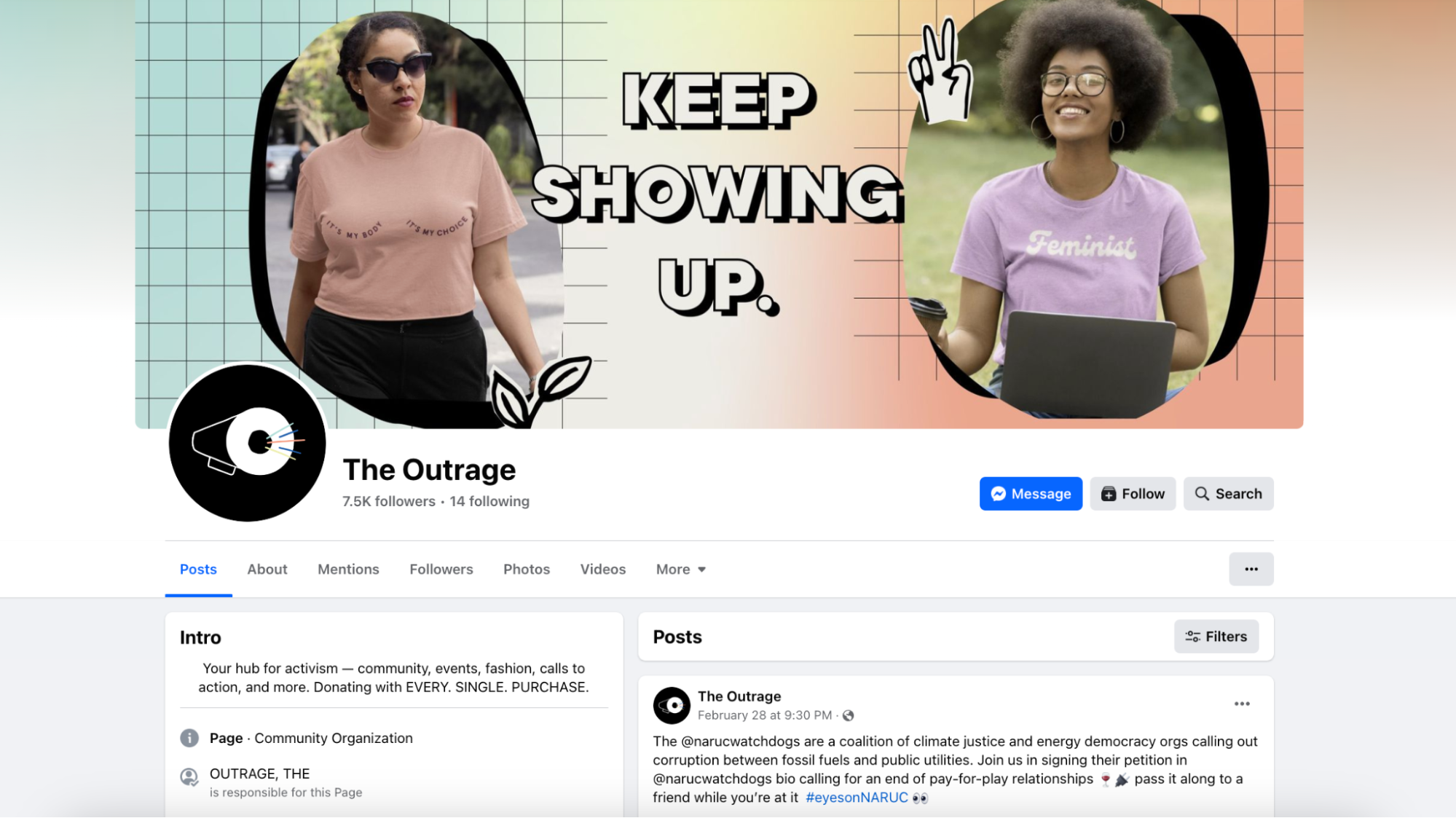
3. Diversify your content formats
Thousands of Facebook posts are eligible to appear in a user’s feed each day. Stand out from the competition by diversifying your content strategy through mixing and matching the different content formats, including:
- Videos
- Images
- Text-only posts
“People don’t visit social media sites to read,” says Callum Dooley, director and business development manager at Elite Wine Refrigeration. “They come for amusement, to catch up with friends, or simply to pass the time. They’ll scroll over your large pieces of data. Go visual to avoid this and increase interaction on your posts. Graphical content should be used instead of text. Create infographics, short videos, memes, and other visual aids to peak your users’ interest.”
Regardless of which content format you begin experimenting with, the most important thing is building a genuine connection with Facebook users using your social media posts.
4. Post when your audience is active
If you’re using Facebook to market your business on social media, you need to post when your target audience is online. Posting at midnight increases the odds of your content being buried once your followers check Facebook in the morning. The Facebook algorithm prioritizes fresh content in a user’s feed.
Research shows the best time to post on Facebook is 10 a.m. on a Friday. Optimal times for your own small business on Facebook may differ based on:
- Where your followers are. Say you start to schedule a ton of Facebook posts to go out at 9 a.m. each day, but you’re in North America and your audience is in Australia. So if it’s 9 a.m. your time, it’s actually 1 a.m. where they are.
- Whether you’re selling to businesses (B2B) or consumers (B2C). You’ll see a correlation between people’s daily routines and the time they spend on Facebook. Office workers, for example, are likely to use Facebook during their commute and lunch breaks.
To find your optimal posting times, schedule content at different times throughout the week and monitor your Facebook Insights. Eventually, you’ll begin to find windows of high engagement—and periods of time that send your content into a Facebook black hole.
5. Share influencer, user, or collaborative content
Marketing is all about influence. Whether you’re persuading your Facebook followers to follow your page or to buy a product you’re promoting, get a helping hand by partnering with influencers. Each generation is influenced by popular social media users—particularly millennials and Gen Z.
Popular ways to collaborate with influencers include:
- Paying for a sponsored post
- Having the influencer “take over” your Facebook page for a day
- Sending free products to the influencer with the hope they’ll share it with followers
It doesn’t have to be mega-influencers with thousands of followers who contribute toward your Facebook page growth.
“Your customers are probably already raving about your brand by sharing photos, videos, and reviews,” says Leo Livshetz, founder and CEO of UnHide. “You can use these pieces of content, with consent, to easily show your target audience that your customers love your products. This will likely continue to be a social media trend moving forward, with brands utilizing Facebook Stories, along with TikTok, to showcase their happy customers.”
Take this example post from Pott’d, which features a video of a customer’s mug-painting party.
In addition to collaborating with influencers, consider partnering with other brands in order to increase your reach to new audiences similar to yours.
According to Alex Danco, director of blockchain and systems thinking at Shopify, the biggest opportunity flying under the radar is collaboration.
“It’s the best way to increase the number of buyers who know and care about you in a way that turns you into not competitors, but cooperators, perhaps even allies and friends,” Alex says.
6. Encourage people to leave Facebook reviews
Some 98% of people look for reviews before buying something online. Testimonials from happy customers, particularly those in a similar position to your target market, go a long way in turning Facebook into a revenue generator for your small business.
Find your Facebook reviews by going to facebook.com/username/reviews. Direct existing customers toward the link through purchase confirmation emails. Incentivize them to leave a review—and become a repeat customer—with a 10% discount on their next purchase in exchange for a testimonial.
Cocopup, for example, has almost 100 reviews on its Facebook page—the majority of which are positive. It goes a long way in proving to new followers debating whether to follow your page (or purchase your products) that it would be a good decision.

7. Get involved with Facebook groups
There’s an online community for almost every hobby you can think of. More than 1.8 billion Facebook users are active in groups at least once a month, from local community forums to groups for pet owners with a specific breed of dog.
Identify the Facebook groups your target market is participating in by surveying existing customers. You can also do a Facebook search for your industry and filter by group.
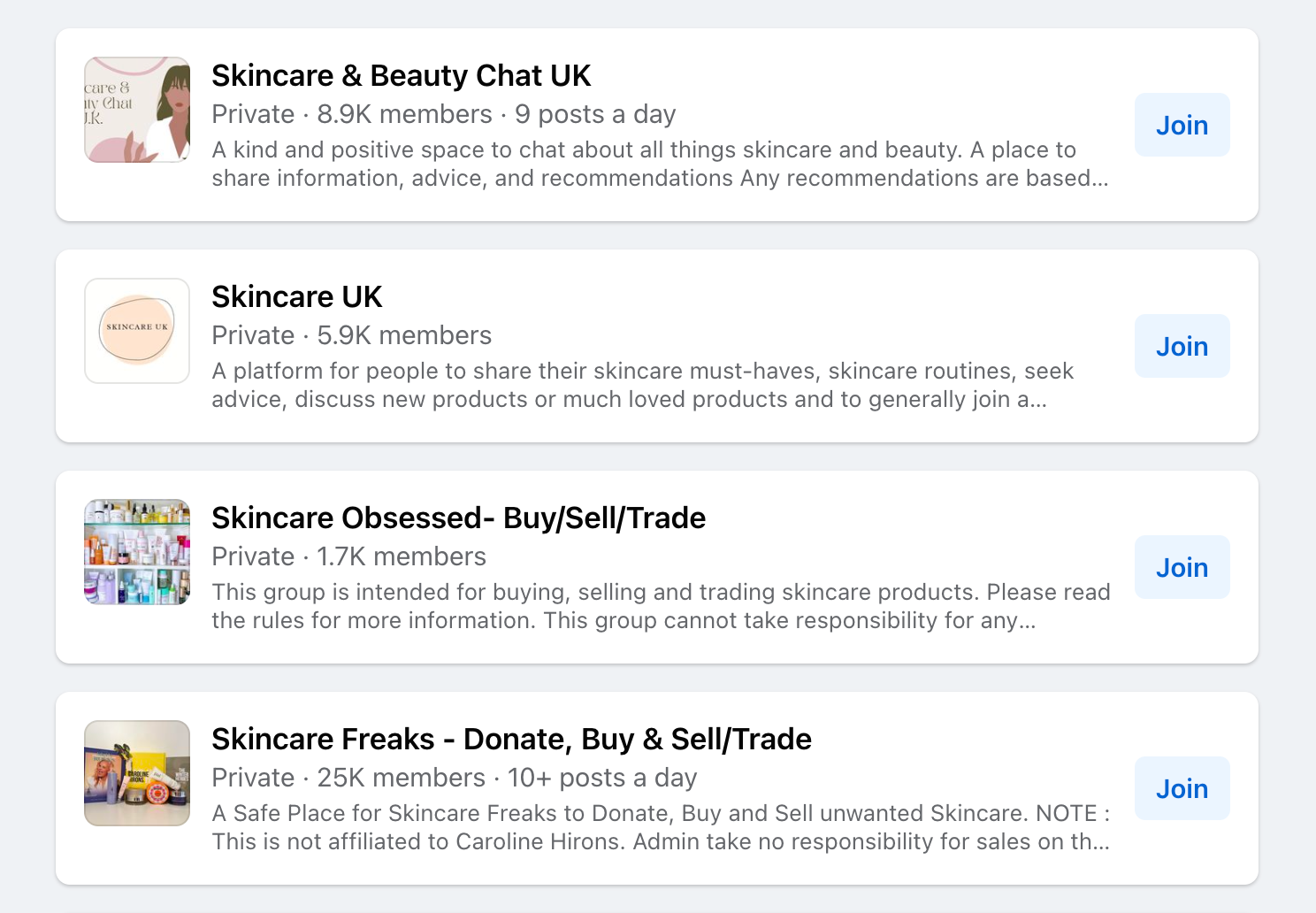
Once you find them, start engaging with content in the group to build awareness on Facebook. Be aware that some Facebook group admins set strict rules for the community. Double check you’re permitted to share promotional content to avoid getting banned.
To mitigate this (and promote to their heart’s content), some brands have seen success in founding their own Facebook group. Tribe Beauty Box, for example, sells beauty subscription boxes through its ecommerce store. Founder Bili Balogun told Shopify Masters about how she created a Facebook group that got its first 200 members quickly.
“I already had an email list, through my website, so I invited people to the group by sending an email to my email list, like, “Hey, we have this amazing group. Please join for behind-the-scenes and exclusive content,” says Bili.
8. Retarget website visitors
It might be necessary to run Facebook ads in order to reach your target audience on a regular basis. A paid Facebook marketing strategy can help boost views of your Facebook business page and drive more traffic to your website.
If you’re new to Facebook advertising, start by retargeting people who’ve previously engaged with your brand. There’s little work that needs to go into educating your advertising audience because they already know your business and product exists.
Build Facebook custom audiences for people who have:
- Visited your website
- Interacted with your mobile app
- Engaged with a video you posted to Facebook
- Already bought a product from you
- Added an item to their online cart
You’ll need the Meta pixel set up to track this data. The pixel will collect information about people engaging with your app or website, then match them with a Facebook user profile.
Even if your business is relatively small, you’ll likely have a large group of people who fall within these custom audiences. The vast majority (around 97%) of people visit a website and leave without purchasing something. Appearing in their Facebook news feed is a reminder to purchase the products they showed an interest in.

9. Run ads with influencer endorsements
We’ve already touched on the power that influencers hold when marketing a business on Facebook. But it’s not just organic posts that you can reshare to your business’s Facebook page. Use influencer endorsements in your Facebook ad campaigns to capture someone’s attention and stop them from scrolling past your ad in their news feed.
Here’s an example from deodorant brand Fussy, a retailer that uses a quote from an influencer in its Facebook advertising campaigns to build trust and credibility. The recognizable name is something its audience can connect with, even if they’ve never heard of the brand or its products before.
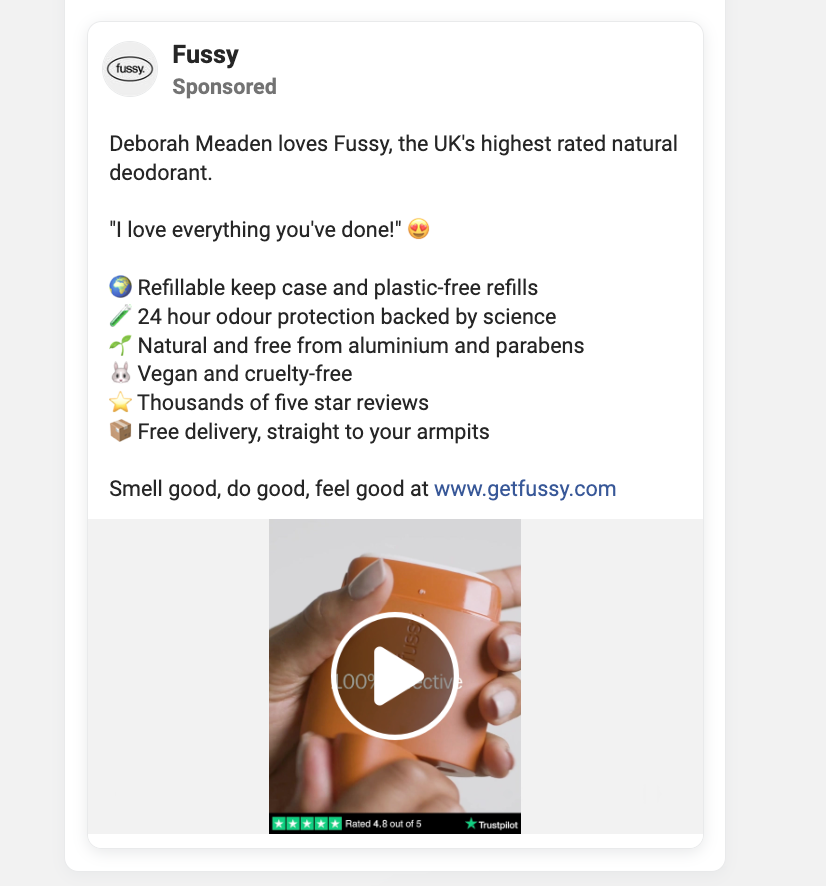
10. Run A/B tests
The first Facebook ad campaign you create won’t necessarily be the winner. Much like organic posting, finding the advert with the highest return on investment takes some experimentation.
Use Facebook’s built-in A/B testing tool to experiment with:
- Ad format. From Canvas ads to image carousels, some Facebook ad formats attract more attention than others. Use different formats within an ad set to see which your target audience engages with the most.
- Placement. The Facebook news feed is often regarded as prime real estate for advertisers. Test whether that’s the case for your small business, or whether alternative placements—like the right-hand column or Meta Audience Network—perform better.
- Campaign objective. Facebook’s advertising algorithm uses the campaign objective to build audiences and bill advertisers. Local businesses might see success with page like or lead generation objectives, whereas ecommerce brands often set their goal as conversions.
- Call to action. Beneath your ad creative is a small CTA button. Test whether Book Now, Shop Now, or Learn More does a better job of convincing your audience to complete the goal.

Austin Dixon, chief marketing officer at hair loss prevention shop Adegen, is one marketer who has seen success by changing the landing page for his Facebook advertising campaigns.
“While most advertisers are focused on pitching their products directly from ads, we take a bit of a different approach,” Austin says.
“We lead with a value- and education-first mentality, so instead of running ads to our product pages, we run our ads to a podcast episode that our founder was featured on. In that podcast, we lead people to a free ebook, and eventually to our Facebook group.
“Because of this, consumers feel very educated about what’s causing their hair loss before we ever introduce our products to them,” Austin says. “As a result, our ads see a six-times return without ever really having to sell prospects on why our products are superior.”
11. Turn Facebook audiences into email subscribers
It’s all well and good to build an audience for your Facebook pages. More followers equals a greater pool of people to promote your products to.
However, many marketers see Facebook marketing as building an audience on rented land. The platform can shut down your page, limit organic reach, or change its algorithm unexpectedly—all of which impact your ability to connect with your audience.
Mitigate risk by turning your Facebook audience into email subscribers. Run advertising campaigns that direct your target audience to a lead magnet, such as a:
- Quiz
- Coupon
- Free workbook
It’ll give you a direct line of communication with your target audience—a way to contact them if the worst did happen.
Facebook marketing tools
Facebook & Instagram app
Shopify’s Facebook & Instagram app is the ideal marketing tool for business owners who want to promote their products on either platform. It’s free to use and syncs with your Shopify dashboard, making it easy to:
- Set up a Facebook Shop
- Tag products in your Facebook posts
- Create Facebook ads from your Shopify dashboard
Buffer
Buffer is a social media scheduling tool that syncs with Facebook alongside other social media channels including Instagram, Pinterest, and LinkedIn. It gives a bird’s-eye view of your entire content calendar for the month. You can also use its analytics tool to find your optimal posting times and schedule posts in advance—no reminders or alarms required.
ManyChat
Facebook Messenger is the platform’s own instant messaging feature that allows you to chat with potential customers through Facebook.
If these private messages become too hard to manage, or you’d simply like to create marketing funnels that give people instant responses to their messages, use ManyChat—an automation tool that helps qualify leads, send order updates, recover abandoned carts, and share coupons with potential customers.
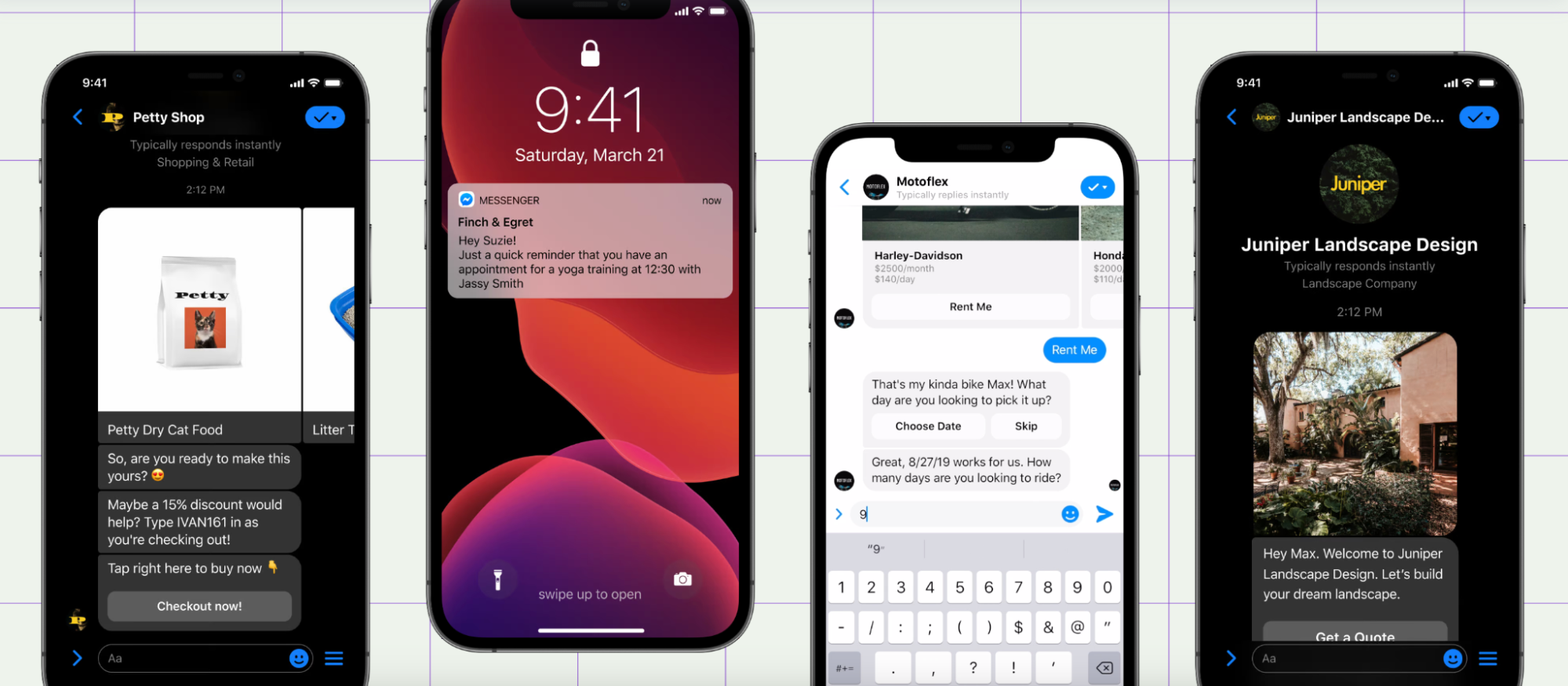
How to get started with Facebook advertising
If you’ve got some cash to splash on Facebook advertising, here’s how to create ads on the platform.
1. Create an ad account
Head back to your Meta Business Suite and create a new ad account that’s associated with your Facebook page. Choose Ads in the left-hand sidebar, then follow the instructions to create your account.
2. Choose a campaign goal
Facebook gives businesses a ton of flexibility when it comes to choosing a campaign goal. You can raise brand awareness (by boosting a post) or optimize for sales, leads, messages, or website traffic.
This step is important because Facebook will build audiences of people who are most likely to complete that goal. If you’re optimizing your campaigns for website visitors, for example, Facebook will find people who have a history of clicking links from other advertisers on the platform.

3. Design your creative
Ad creative describes the actual content users see when your Facebook ad appears in their news feed. Choose a previous post to boost, or create a new one using the creative manager. Experiment with social proof, emojis, and short and long-form copy to see which creative your audience is most likely to engage with.
4. Build Facebook audiences
Now’s the time to tell Facebook the type of person you want to reach with your campaign. Use the audience builder to specify your target audience’s:
- Location
- Interests
- Demographics
If you’re running Facebook ads for a luxurious coffee store in Chicago, for example, you might want to target people within a 25-mile radius of your store, who have an interest in coffee, and who are in the the top 25% of household income within that ZIP code.

5. Set your budget and campaign duration
You can either set a start and end date for your campaign or have it run continuously. Then choose how much you want to spend per day on your ad. Bear in mind that there’s a minimum daily spend of $1 per day if you’re being billed on impressions, or $5 per day for campaigns that are billed on engagements (such as clicks, likes, or video views).
6. Test your campaigns
Once your ads have been approved, Facebook will start to show your campaign to the audience you specified. Repeat this process for as many ads as you’d like to create.
Give the ads a few days to bed in—it can take a while for the algorithm to match your ads with the right audience, especially if it’s your first campaign. After about a week, you’ll start to notice some creative posts, audiences, or placements perform better than others. Readjust your campaigns to assign more budget to the best performing Facebook ads to get the highest return on investment.
Facebook marketing costs
It’s free to market a business on Facebook. Anyone can start a Facebook business page, add their branding, and start posting social media posts that reach their target audience without a big marketing budget.
That said, it’s becoming increasingly hard to get seen in a crowded news feed. The social media platform is turning toward a “pay to play” model—which makes sense considering Facebook earns money from advertisers.
If you do have a marketing budget to spend, expect to pay around:
- 60¢ per click
- $9.32 to reach 1,000 people
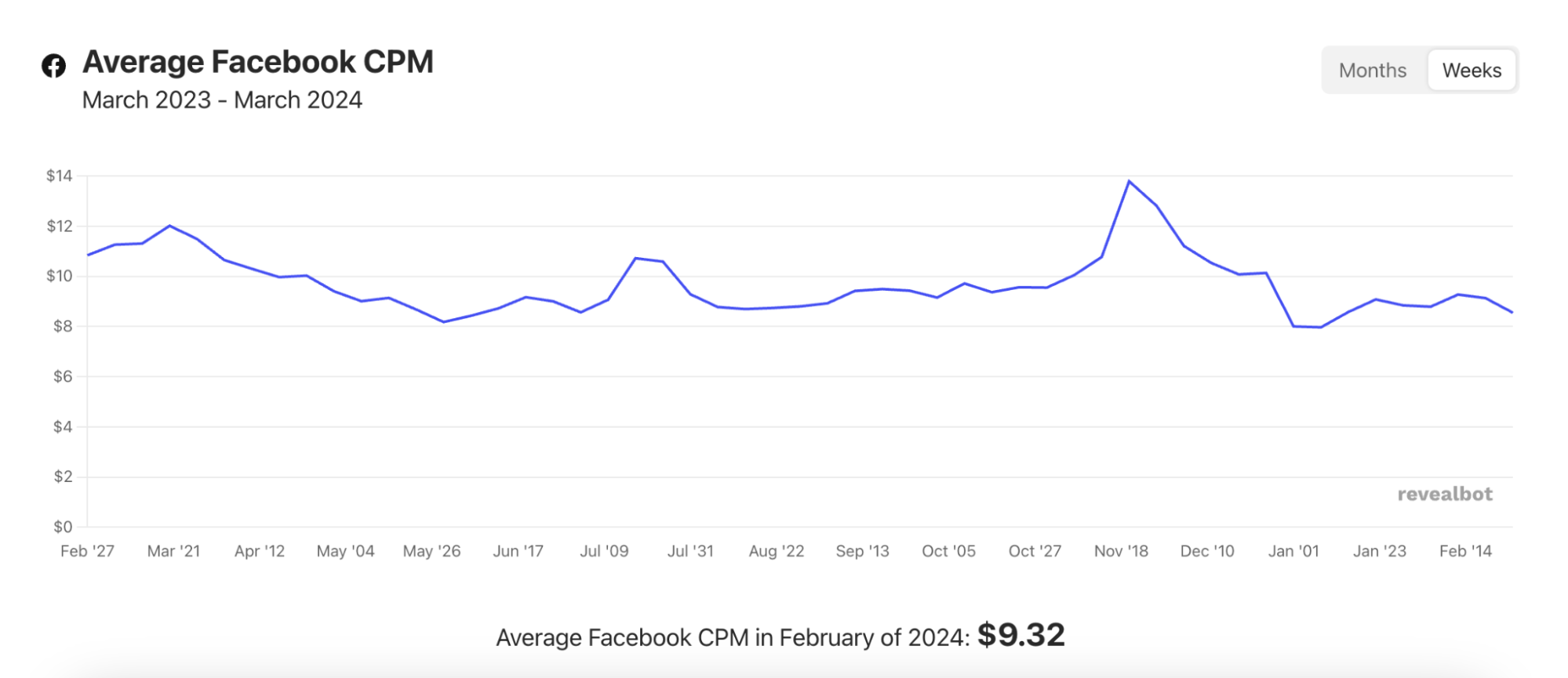
Don’t feel intimidated by these numbers if you have a tiny budget to play with. You can start advertising on Facebook for as little as $1 per day. This ad spend is a small price to pay for the thousands of people you could reach on Facebook.
Examples of Facebook marketing strategies
Magic Spoon
The sheer volume of content posted to Facebook every day means it’s hard for brands to stand out. However, cereal and snack brand Magic Spoon goes above and beyond traditional photo posts. It encourages people to comment on its photo posts by asking them to vote for their favorite flavors. This engagement shows the algorithm that its posts are engaging and worth promoting to other users.
Tiny Hands
Tiny Hands is an online retailer that sells scented food jewelry for kids. Founder Mei Pak says its Facebook marketing strategy was largely rooted in trial and error.
“A week will go by and I’ll go back to [two] posts of these two separate videos on different topics,” says Mei. “I’ll see how people have responded to it and how many comments, how many shares, how many likes they’ve gotten. Also, if people have left a comment, what did they say?
“The easiest thing you can do is to look at the engagement numbers, likes, comments, and shares. That will give you a really great idea for how much people like that topic that you just shared.”
This experimental approach to Facebook helped Tiny Hands build a Facebook audience of more than 66,000 people to date.
BLK & Bold
It’s easy to fall into the trap of thinking that every Facebook post should divert people toward your online store. Sometimes, the most effective way to drive traffic is to build trust amongst your audience. BLK & Bold does exactly that with these non-salesy posts that show its team members’ favorite coffee.
Track performance with Facebook analytics
The secret to Facebook marketing success is experimentation. What works for one small business doesn’t work for another. It’s more of an art than a science, which is why it’s so important to track the detailed analytics associated with your Facebook marketing strategy.
Understand whether your strategy is working by monitoring Facebook Audience Insights. Important key performance indicators to pay attention to include:
- Audience growth. How many followers have you accumulated since starting your Facebook marketing strategy? Lots of new followers is a good indicator that you’re on the right track.
- Follower demographics. Assess whether Facebook followers are likely to convert into potential customers by comparing them against your target market. You’ll see the top countries, age ranges, and gender splits that form your Facebook audience.
- Number of unfollows. Your job isn’t over once someone follows your Facebook page. Assess how good you are at retaining them by monitoring your unfollow rate.
- Where follows happen. Discover where people followed your page—either by search or the page itself—and prioritize appearing there more often. This is especially important if you have limited time to focus on Facebook marketing.
- Actions on page. How many people click the call to action (CTA) in your Facebook bio? See whether your organic content is driving traffic to your website, get directions, or call your small business.
- Success by post type. Varying your content strategy is a good way to start marketing a business on Facebook. Find which formats your audience engages with the most through this report.

Take your Facebook marketing strategy to the next level
Facebook is a behemoth of a social network, but it’s still a valuable tool for marketers to reach their target audience—whether you have money to invest or not.
Experimentation is the key to Facebook marketing success. Test which content formats, campaign objectives, and posting times do a better job of engaging your audience. Facebook’s Insights tool will unveil the best route to conversions.
Facebook marketing FAQ
Is Facebook good for marketing?
Facebook marketing is a great way to market your business. Billions of people use the platform every day. Likely, that includes your target customers. Reach them by posting content to your business’s Facebook page.
Is Facebook marketing free?
It’s possible to market a business on Facebook for free by creating a page and publishing content organically. Increase your follower count to build an audience of people who will see and engage with the content you share.
Can I advertise my business on Facebook?
Any business can advertise on Facebook, provided they don’t fall into a special ad category such as housing, politics, or loans.
How do I make my Facebook page grow from zero?
- Create different types of posts.
- Brand your Facebook page.
- Share content from influencers.
- Repost user-generated content.
- Join Facebook groups.
- Encourage people to leave reviews.
- Invest in Facebook ads.




لا تعليق